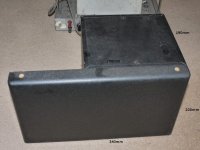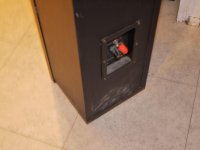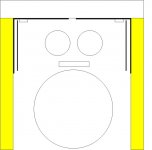I'm risking going way OT on this, so @Tom: stop me if I am dragging things the wrong way, but figured some discussion on packaging options might be interesting. After all the mod-86 is small enough and can be made low power enough for some neat installations.
So as I am making my speakers active, as well as converting them to open baffle operation, seems churlish not to try and pack the amps in whilst I do it. Plus it means the box is hidden, and nice metalwork was never my strongpoint 🙂
So I have the stands (first picture), or the bottom of the enclosure (most of which will be cut out to make it OB). Nothing is allowed to stick out at the sides and sadly I can't replace the 350mm wide front of the stands as heatsink (sob).
options for 2 heatsinks are limited so looking at a single of around 0.5C/W (200x150x40mm profile). If I could mount the Mod-86 parallel to the heatsink then all hunky dory, but with 190mm depth would have to put the boards vertically with the PSU caps in between.
Just working up a drawing to make sure I've taken everything into account, then I can work out how to build the metalwork.
So as I am making my speakers active, as well as converting them to open baffle operation, seems churlish not to try and pack the amps in whilst I do it. Plus it means the box is hidden, and nice metalwork was never my strongpoint 🙂
So I have the stands (first picture), or the bottom of the enclosure (most of which will be cut out to make it OB). Nothing is allowed to stick out at the sides and sadly I can't replace the 350mm wide front of the stands as heatsink (sob).
options for 2 heatsinks are limited so looking at a single of around 0.5C/W (200x150x40mm profile). If I could mount the Mod-86 parallel to the heatsink then all hunky dory, but with 190mm depth would have to put the boards vertically with the PSU caps in between.
Just working up a drawing to make sure I've taken everything into account, then I can work out how to build the metalwork.
Attachments
Well it's a tight fit even without I/O, and one board will be upside down, but I think I can do it. Dropping the transformer to 120VA gains 20mm if I start to struggle. Would appreciate any thoughts on how it could be made more compact (other than reducing power).
Attachments
Most everybody else who sells a power supply for a 2x50W pair of chipamps, doesn't bother to heatsink the rectifier diodes. You could roll your own power supply board, with reduced output capacitor sizes (suited for half the power of the stock M86) and with no heatsink on the rectifiers (since the diode current is halved). Roll-your-own also gives you the freedom to optimize the board's aspect ratio, to suit the empty space available in the cabinets. The existing PSU board is ~approx square, which minimizes PCB fab cost but may not be optimum in your one-of-a-kind situation.Would appreciate any thoughts on how it could be made more compact (other than reducing power).
The power supply PCB for my chipamps uses four 6A4 discrete diodes (link) without heatsinks, and works fine at 2x50W. If you're still skeered you could pay a little more money for the 10A04 diodes which are rated for a lot more power in the same package (link 2). How? Bigger die inside.
well I have not assumed a power supply board, so I just marked the size of the caps for a stock M86 and a small box for the (as yet undefined bridge). The GBU2510 Tom looks like he is using in the power86 is in a small case, so I would heatsink, or bolt to the baseplate. I wouldn't want to drop below 22000u per rail and they are only 35mm diameter, so fine. I am still doing the vertical layout, as the mod-86 boards should start above the height of the caps.
there is always the vertical mounting of the transformer to consider as well.
EDIT: had also forgotten the connex SMPS300RE, which would could a bit more but saves a lot of space.
there is always the vertical mounting of the transformer to consider as well.
EDIT: had also forgotten the connex SMPS300RE, which would could a bit more but saves a lot of space.
Last edited:
The GBU2510 Tom looks like he is using in the power86 is in a small case, so I would heatsink, or bolt to the baseplate.
That would be my choice for mounting as well. For the Power-86, I didn't want to paint the customer into a corner by requiring that the board be mounted near a chassis edge or otherwise within reach of an existing heat sink surface. Also, by specifying the heat sink, I have a better control over the thermal system and can ensure that the rectifier will survive even if the customer connects more than two channels to a supply board and runs the channels at the published headline power specs. Math. Useful. 🙂
I deliver products that are well engineered, well designed, well tested, well characterized, well documented, and well supported. Other vendors are free to have their own value propositions and optimize differently.
~Tom
talking of small heatsinks, I was perusing the linkwitz labs site this evening trying to get my head around dipole equalisation and stumbled across the pluto amplifier Pluto electronics
50W for the tweeter and 100W(ish) for the woofer (bridged) on 30v rails. Teeny heatsinks. As SL is a designer I respect rather than yer average Joe you can see how much crest factor can save you. I also suspect the drive units start to barf before the amplifiers do!
Mind you SL also does not listen to heavy metal, only classical as far as I can tell. Personally I would think that is thermally a bit close to the edge for my liking.
50W for the tweeter and 100W(ish) for the woofer (bridged) on 30v rails. Teeny heatsinks. As SL is a designer I respect rather than yer average Joe you can see how much crest factor can save you. I also suspect the drive units start to barf before the amplifiers do!
Mind you SL also does not listen to heavy metal, only classical as far as I can tell. Personally I would think that is thermally a bit close to the edge for my liking.
talking of small heatsinks, I was perusing the linkwitz labs site this evening trying to get my head around dipole equalisation and stumbled across the pluto amplifier Pluto electronics
Those heat sinks are definitely in the itty-bitty category. Based on my own thermal experiments, I wouldn't go below a Pentium Pro size heat sink (2 ºC/W).
50W for the tweeter and 100W(ish) for the woofer (bridged) on 30v rails. Teeny heatsinks. As SL is a designer I respect rather than yer average Joe you can see how much crest factor can save you. I also suspect the drive units start to barf before the amplifiers do!
Respected or not, sometimes designers forget to do the math. Or they post pictures of a prototype... If the woofer amp is indeed bridged, it makes absolutely no sense with the teeny-tiny heat sinks.
I suspect the actual limit of the system is set by the excursion limit of the woofer. I'm sure that happens way before the woofer amp reaches peak output power.
~Tom
Real driver loading effects distortion figures. I think the inductances contribute more to the distortion than capacitance. I normally like to use a circuit with an impedance similar to a full range driver just for some sanity checks.That I like. I actually did a frequency sweep with a 2-way sealed box speaker connected. I didn't see any oddities that would indicate trouble. A speaker model would be nice, though. It certainly would be quieter... 🙂
BTW: Is anyone aware of a similar load for headphones? I know they exist, but haven't seen a schematic.
My amplifier torture experiments involve capacitive loads. I ran the MOD86 with 8 Ω in parallel with 1 nF .... 220 nF and looked at the transient response. As you'd expect, the resonance between the Thiele network inductor and the load capacitance causes some ringing. The amp behaves rather well even with a significant capacitive load.
~Tom
I am very impressed by the approach taken by Tom and I decided to start the project, despite I do not need a new amplifier... But I am interested to check how this design sounds... So I will compare with more traditionnal amplifiers (Mark Levinson, Kaneda and other) and I will report my impressions here.
I have ordered the PCBs. Congratulations to Tom for the quality of the design documentation! This is perfect!
One word concerning European customers. For us, this is far to be a cheap amplifier. Mouser is convenient, but very expensive. They charged me 100 Dollars for delivery... Their web site is translated in German and French, but this is only when I placed the order that I discovered the prices were ex VAT and the cost of the shipment via FEDEX. At the end of the day, this will make this project a 600 Euros amplifier, which will be too expensive for most of the interested customers in Europe.
I have unfortunately no time to do it myself, but it would be nice to have a BOM available in one of the European retailers for electronic components, like Conrad...
Dominique
I have ordered the PCBs. Congratulations to Tom for the quality of the design documentation! This is perfect!
One word concerning European customers. For us, this is far to be a cheap amplifier. Mouser is convenient, but very expensive. They charged me 100 Dollars for delivery... Their web site is translated in German and French, but this is only when I placed the order that I discovered the prices were ex VAT and the cost of the shipment via FEDEX. At the end of the day, this will make this project a 600 Euros amplifier, which will be too expensive for most of the interested customers in Europe.
I have unfortunately no time to do it myself, but it would be nice to have a BOM available in one of the European retailers for electronic components, like Conrad...
Dominique
Hi,
I haven't hit the order with Mouser yet, but mouser have a UK presence (uk.mouser.com) which is free shipping over £50. I can always help if they wont ship cheaply to Germany.
Bill
I haven't hit the order with Mouser yet, but mouser have a UK presence (uk.mouser.com) which is free shipping over £50. I can always help if they wont ship cheaply to Germany.
Bill
Germany is Mouser's main EU branch. If it's 100 euro to ship inside Germany, well, ow. Sounds like maybe the order wasn't submitted through http://www.mouser.de, though as a quick check 6.47 euro for a 1200 is pretty close to 5.03 pounds.
Last edited:
Dear Bill,
Thank you for the offer! Too late for me, but this is good to know for others who might be interested by the project!
Dominique
Thank you for the offer! Too late for me, but this is good to know for others who might be interested by the project!
Dominique
For information, I went to mouser.de and the order was placed via their branch in Munich (I have an email from them). The only thing I did was to change the language from German to English.
May be a bug? Should I complain?
Cheers
Dominique
May be a bug? Should I complain?
Cheers
Dominique
you should certainly complain and be given the chance to cancel the order and get it shipped from germany instead of USA
Thank you, I just sent an email.... Further to Bill information, I checked the German site and they also mention the free shipment for orders over 65 Euros.
So there is a bug somewhere, may be because the Project was created from the USA?
My first experience with Mouser, I will call the office in Munich tomorrow.
Dominique
So there is a bug somewhere, may be because the Project was created from the USA?
My first experience with Mouser, I will call the office in Munich tomorrow.
Dominique
Last edited:
I test drove the project link using Mouser Electronics - Distributor elektronischer Bauteile. The links in my design doc are all referencing the US Mouser site, but simply changing ".com" to ".de" in the links brought up the German site and prices in Euro. I would imagine that Mouser would automatically perform the substitution of the top-level domain, so if you normally use Mouser.de, you get taken there by default even when following a US Mouser project link.
Anyway. I was able to get the project to come up in German with pricing in Euro. I did not test the ordering or shipping terms, however.
The components in the Modulus-86 are pretty generic and should be available from just about any major electronics parts distributor carrying TI and THAT Corp. ICs.
~Tom
Anyway. I was able to get the project to come up in German with pricing in Euro. I did not test the ordering or shipping terms, however.
The components in the Modulus-86 are pretty generic and should be available from just about any major electronics parts distributor carrying TI and THAT Corp. ICs.
~Tom
Decided to order two boards. This is going to be interesting because I plan to compare it against the MyRef RevC with my modifications. Switching power supply.
Decided to order two boards. This is going to be interesting because I plan to compare it against the MyRef RevC with my modifications. Switching power supply.
Thank you very much for your order. Your boards will be in the mail in the morning.
Please post your findings and comparisons. I'm curious how the MOD86 stacks up against the MyRef.
~Tom
I new that layout is part of the circuit, but after doing various simulations, and discovered how much it means, I am even more confused as to how to best control it. I did a sim of the Myref, and it made a difference in the frequency response in a very significant way when you start to look at different loading impedance curves and how the ground resistance. You can expect I am going to also study your design as well. I doubt my findings will be of any conclusion, but I think these are going to be very interesting subjects. It would be interesting if the trace resistances can be back modelled into spice to see how good a layout is.
I spoke to mouser today and I got the explanation.
They keep no parts inventory in Europe. Everything is shipped from the USA (It is not obvious when you connect to the site in Europe).
The free shipment over 65 Euros is subject to conditions.
The not too funny thing is that I decided not to order the Antek transformer in order to avoid shipment from the states (and associated costs). So I ordered a more expensive one from Mouser (As I understood I was ordering in Germany), and this is the reason why suddenly, they added up this extremely expensive shipment cost.
So I have lost on two aspects: I could have saved The shipment cost by ordering the Antek, and saved on the cost of the transformer itself.
I hope this bad experience will be useful for others...
I have tried to cancel the order. It is easy to do with Amazon, but impossible with Mouser.
Dominique
They keep no parts inventory in Europe. Everything is shipped from the USA (It is not obvious when you connect to the site in Europe).
The free shipment over 65 Euros is subject to conditions.
The not too funny thing is that I decided not to order the Antek transformer in order to avoid shipment from the states (and associated costs). So I ordered a more expensive one from Mouser (As I understood I was ordering in Germany), and this is the reason why suddenly, they added up this extremely expensive shipment cost.
So I have lost on two aspects: I could have saved The shipment cost by ordering the Antek, and saved on the cost of the transformer itself.
I hope this bad experience will be useful for others...
I have tried to cancel the order. It is easy to do with Amazon, but impossible with Mouser.
Dominique
- Home
- Vendor's Bazaar
- Modulus-86: Composite amplifier achieving <0.0004 % THD+N.


